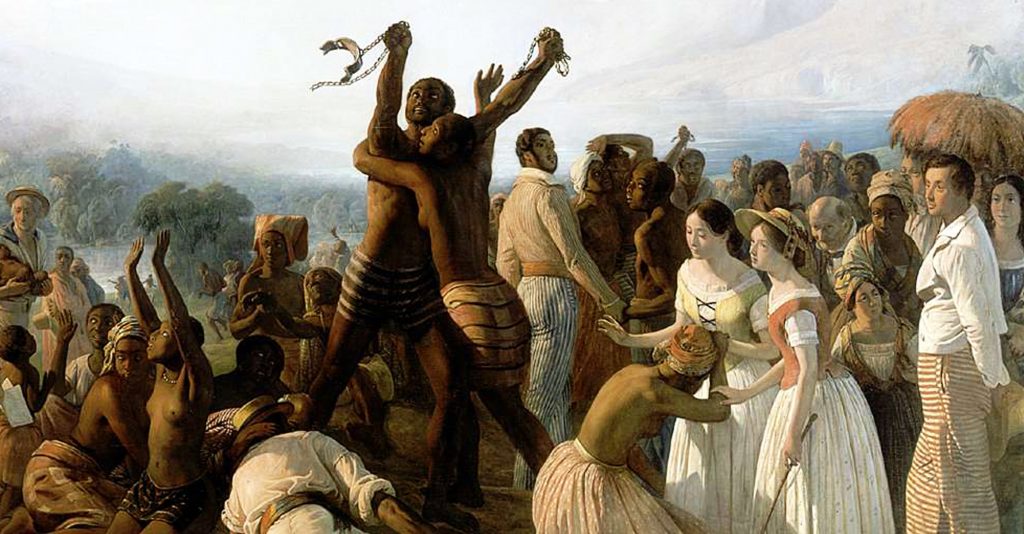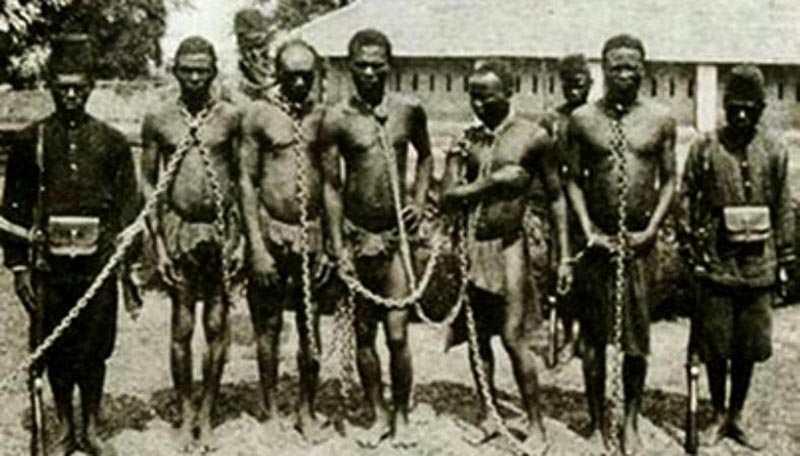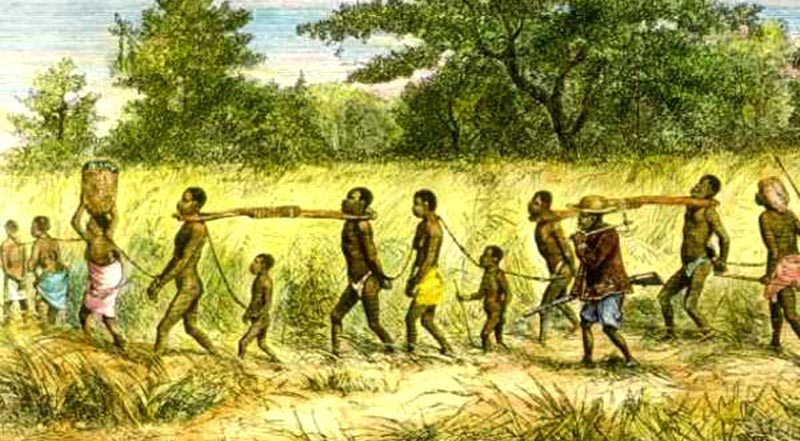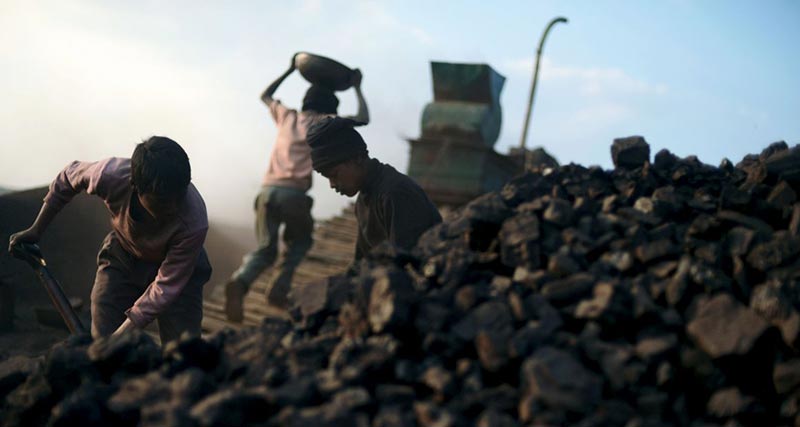Slavery – Everything about Slavery in Brazil and the World
A slavery It is an ancient practice that still exists today, where human beings assume property rights over others, which are imposed through force. Slaves were not only black as is shown most of the time, there were white slaves and Indians too, it didn't matter the color but the situation at the time. They were made slaves in general, prisoners of war and people with debts and even even for moral and religious reasons.
Origin of Slavery (When did it start?)
It is not known for sure when slavery began in the world, there are several occurrences of slavery in different forms throughout history and were practiced by different civilizations and in different ways that we can consider a type of slavery.

Art made by François Auguste Biard (1848) (click to enlarge)
In a general and primary way, slavery occurred as people with different interests, mainly religious, fought and this resulted in prisoners of war, who in turn became slaves in the hands of their enemies.
In some other ancient cultures, a social hierarchy similar to that of slaves was reserved for women, denying them basic rights that would constitute the notion of citizen.
Slavery in Africa
Slavery in Africa began around 1450 with the sale of gold and also coincides with the beginning of the Age of Discovery, where many men were needed, both for gold mining and for building ships.

Given the need for so many men and the lucrative black trade, some black villages captured other blacks to sell to whites as slaves, the Portuguese were the main buyers and they also resold to Muslims.
Thus, it appears that the slave trade that was established in Africa between 1450 and 1900 involved the sale of more than 11,313,000 individuals.
One thing that is little said about slavery in Africa is that more than 1.25 million Christian Europeans were captured by pirates to work forcibly in North Africa.
Indigenous slavery
Indigenous slavery in Brazil began at the beginning of Portuguese colonization, but there are reports of slavery by Indians for Indians, this practice was carried out by Indians who were not cannibals, because when they were, instead of enslaving enemy tribes they ate them.

With the arrival of the Portuguese in Brazil, the Indians were used to control black slaves and they could even become slaves on their own.
On July 30, 1566, the law was created that regulated the voluntary slavery of Indians for the first time. According to this law, issued by a board convened by Mem de Sá, “Indians could only sell themselves in cases of extreme necessity, and all cases must be submitted to the authority for examination”.
Slavery in the World
Slavery was practiced by many people around the world, slaves were generally made, prisoners of war and people with debts, but later the slavery of black people stood out, with the era of discovery, growth and colonization of countries, slavery has become much more extensive throughout the world.
With this there was a flowering of slavery. A cruel and profitable trade in men, women and children developed between Africa and the Americas. Slavery began to be justified on moral and religious grounds and based on the belief in the supposed racial and cultural superiority of Europeans.
Millions of people were enslaved around the world and to this day we can see this in many places, in Brazil for example, many people are used in a slave manner on crops and also in mining.
Slavery in Brazil
The first black slaves arrived in Brazil between 1539 and 1542 with colonization by the Portuguese, the vast majority of these slaves were brought to work in the fields, as there was a lack of hands for cultivation, this was the first part of the Portuguese colony brought to Brazil. Brazil where sugarcane culture was the initial focus of colonization.
Later, more groups of colonizers came from Portugal and even the Netherlands, disembarking in various ports in Brazil, including Recife, Salvador and Rio de Janeiro, who later left for Minas Gerais and Vale do Paraíba in the state of São Paulo. where slaves grew coffee and worked in the gold mines.
Near the end of slavery in Brazil, more precisely in the 18th century, slaves were treated in the worst possible way. They worked a lot, from fourteen to sixteen hours, which became the main reason for slaves to run away; another reason was the punishments and the other was because they only received rags of clothing and poor quality food.
In the 19th century there were already movements that defended the end of slavery. Several thinkers at that time already considered slavery an abuse and a major problem for any nation that intended to develop.
In 1888, slavery was abolished through the Áurea Law, which was signed by Princess Isabel on May 13 of that year. This measure benefited a large number of slaves that still existed in the country.
Punishments of slaves in Brazil
There were many types of punishments that slaves suffered, the main one was:
- "Stem" where the slave was tied to be whipped, many died in this punishment.
- “Gargalheira” It was another instrument of torture, it was attached to the head and neck of slaves, it was a type of punishment for rebellious slaves, who could spend days with it on their body.
- “Vira – Mundo” In it, there were large and small holes for the feet and hands that were attached inversely, that is: right hand with left foot, left hand with right foot.
- “The Cepo” The block consisted of a thick wooden log that the slave carried on his head, attached by a long chain to a ring on his ankle.
- "The mask" iron artifact attached to the head and neck, a kind of metal plate that covered the mouth, and the slave could only eat when allowed.
Largest slave owners in Brazil
There were many slave owners in Brazil, some had many slaves, but what stood out even to historians was a black man who was a slave, but conquered an empire and had more than 200 slaves in his power, Francisco Paulo de Almeida, He was one of the most important coffee barons, his farms extended across the states of Rio and also Minas Gerais, totaling a vast territory estimated at 250 square kilometers.
Torture instruments to punish slaves
There were many instruments to punish slaves, the main ones are the same ones we talked about above, they are the Trunk, Gargalheira, Vira – Mundo, Cepo and the Mask.
End of Slavery in Brazil
In the 19th century there were already movements that defended the end of slavery. Several thinkers at that time already considered slavery an abuse and a major problem for any nation that intended to develop.
In 1888, slavery was abolished through the Áurea Law, which was signed by Princess Isabel on May 13 of that year. This measure benefited a large number of slaves that still existed in the country.
Brazilian Leaders against Slavery
There were many people who fought against slavery in Brazil, but some stood out in this role.
sea Dragon – Francisco José do Nascimento, known as “Dragon of the Sea”, was one of the great abolitionists of northeastern Brazil. He refused to transport slaves on his raft and, in 1881, he led the rafters' strike against slavery.
Castro Alves – One of the most famous abolitionists, he is famous for his engaging poems, including Vozes d' África and Navio Negreiro. He founded the Sociedade Libertadora 7 de Setembro in Bahia in 1869. Active, he managed to free 500 slaves.
André Rebouças – André Rebouças is one of the great voices of the Brazilian abolitionist struggle. He participated in the creation of some anti-slavery associations, such as the Brazilian Society Against Slavery, the Abolitionist Society and the Central Immigration Society. He defended the emancipation of slaves and their total social integration through the acquisition of land.
Francisco de Paula Brito – one of the biggest names in the Brazilian press. He published “O Homem de Cor”, the first anti-racist newspaper that later came to be called “O Mulato”. He died at the age of 52, in 1861, without seeing the abolition of slavery in his country.
Luís Gama – was the son of a slave mother and a white father. He was sold into slavery at the age of 10 and only learned to read at 17. He gained his freedom by proving to be a free man before the law. He enlisted in the Army, was a police clerk, journalist and lawyer active in support of the abolitionist cause. He freed more than 500 slaves.
Modern Slavery (Labor Slavery today)
There is a certain difference between the slavery that occurred during the colonization of our country and the modern slavery of today, but one thing does not change, which are the intimidating and punitive measures applied to people in situations of slavery.

Currently, modern slavery affects more than 45.8 million people around the world, the vast majority of people in this situation are attracted by false promises of employment and better lives. However, they end up being taken to isolated places, where their documents are withheld and they are linked to a debt, which must be paid off by working for these people for free in the worst possible conditions, truly slavery conditions.
And this is all far from over, as this regime of modern slavery generates more than 150 million dollars a year worldwide, just as modern slavery used to be for exactly the same reason, money.
In Brazil, slavery is most commonly seen in farming, people drop everything for promises of work and end up working on farms without receiving anything in return, or they receive as little as possible, which doesn't even give these workers the conditions to live with dignity.
Slavery and Racism (Fight against Racism in Brazil and the World)
Many people fight in Brazil and around the world against slave labor and racism, but this is a daily fight, because mainly against slavery the fight is usually against powerful people, where a lot of money and even governments are involved, the fight against racism is not that much easier than the fight against slavery, as racism kills many people every year, we all have to become aware and start this change at home with our children, always seeking to make everyone equal, regardless of anything.
End of Slavery around the World
We have separated in chronological order the countries that abolished slavery
- 1590 – Japan
- 1761 – Portugal
- 1792 – Denmark
- 1794 – Haiti
- 1821 – Holland
- 1822 – Dominican Republic
- 1823 – Chile
- 1824 – Honduras, El Salvador, Nicaragua, Costa Rica and Guatemala
- 1826 – Bolivia
- 1829 – Mexico
- 1833 – United Kingdom
- 1842 – Paraguay, Uruguay
- 1848 – France
- 1851 – Ecuador and Colombia
- 1853 – Argentina
- 1854 – Venezuela and Peru
- 1861 – Russia
- 1863 – Dutch Colonial Empire and the United States
- 1873 – Zanzibar
- 1874 – Ghana
- 1876 – Türkiye
- 1886 – Colonial Cuba
- 1888 – Brazil (click and see about the end of slavery in Brazil)
- 1890 – Tunisia
- 1894 – Gambia
- 1897 – Madagascar
- 1906 – China
- 1928 – Sierra Leone
- 1936 – Nigeria
- 1942 – Ethiopia
- 1945 – Nazi Germany
- 1956 – Morocco
- 1962 – Saudi Arabia
- 1981 – Mauritania (but in Mauritania it was only considered illegal in 2007)
